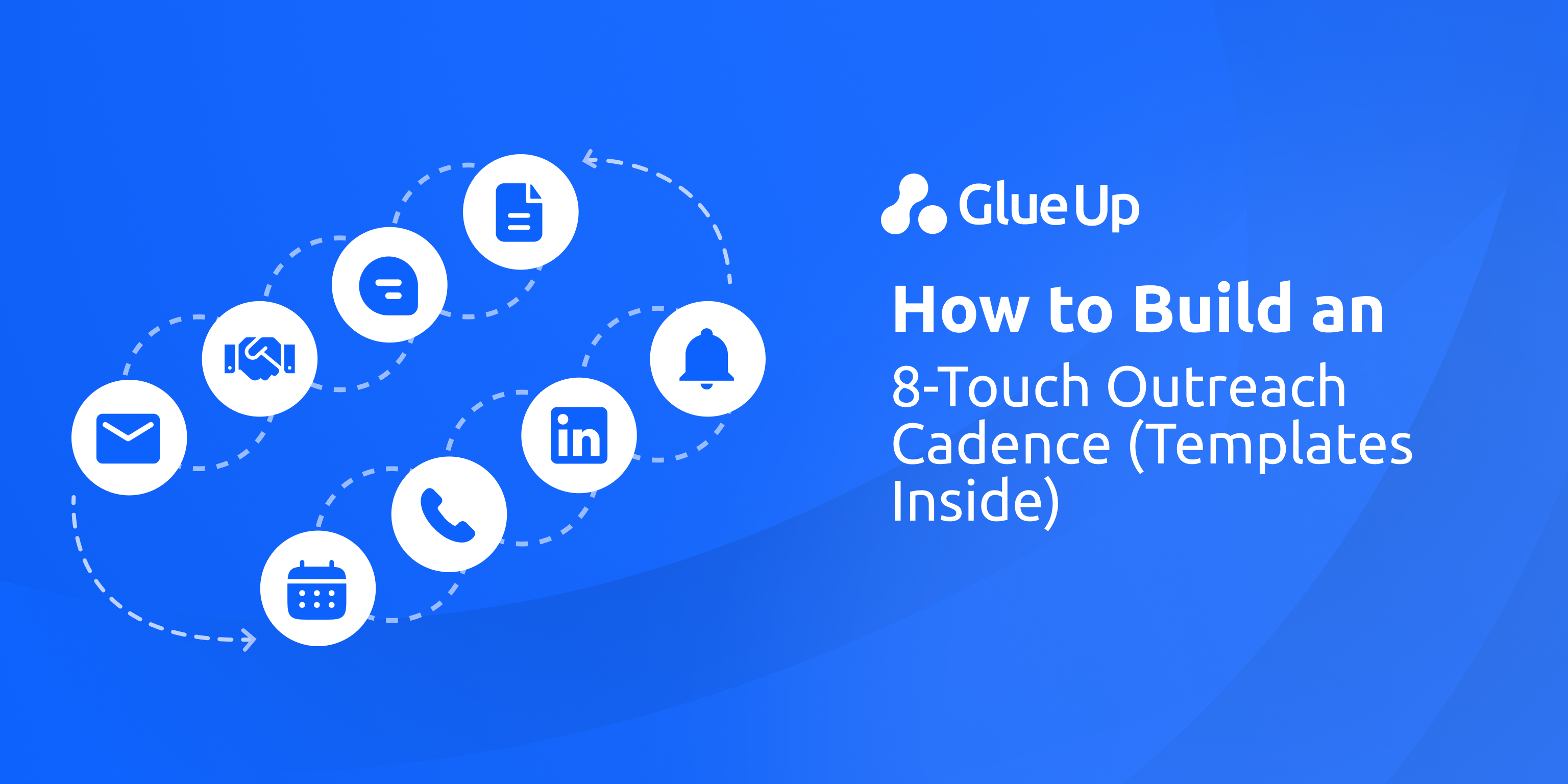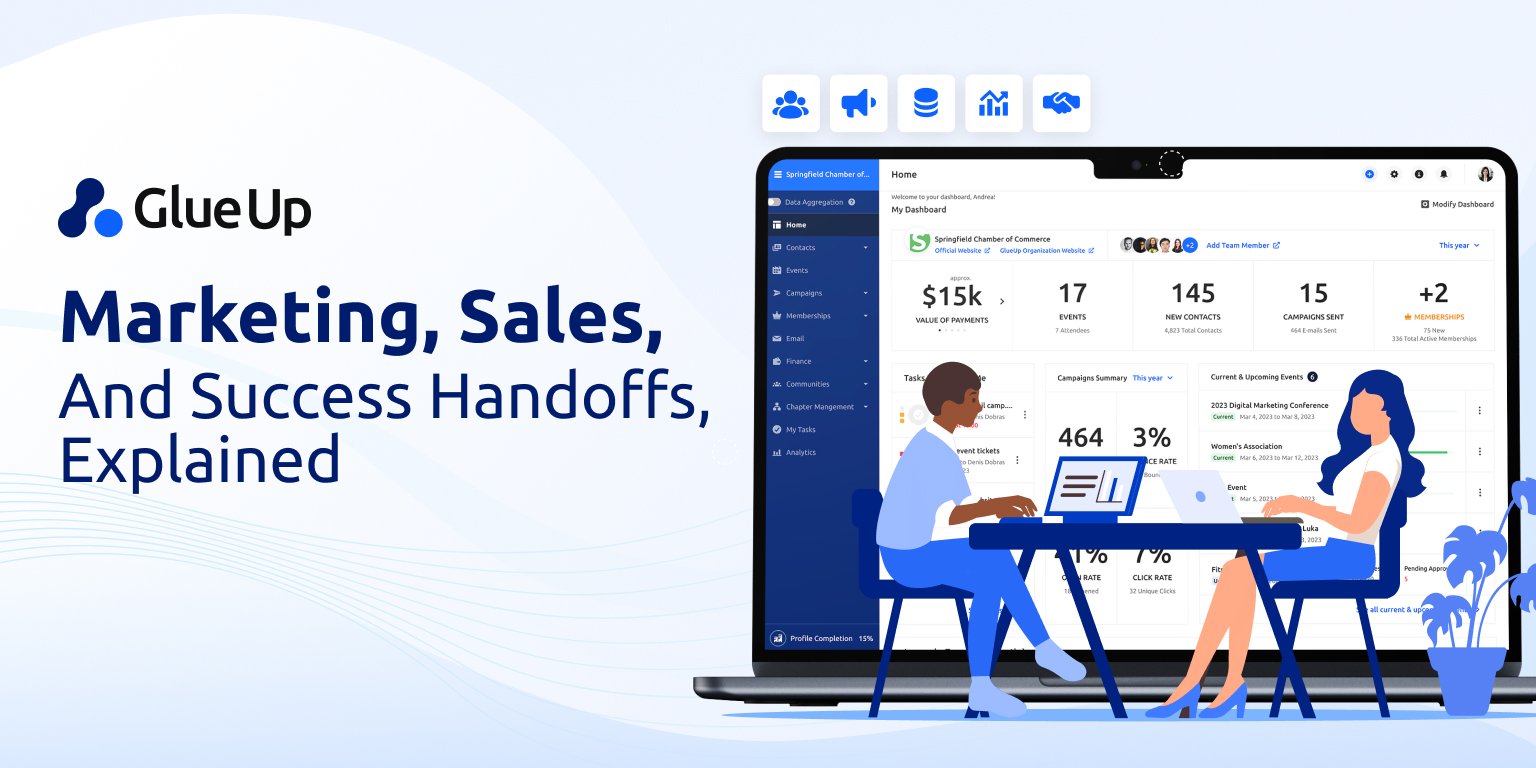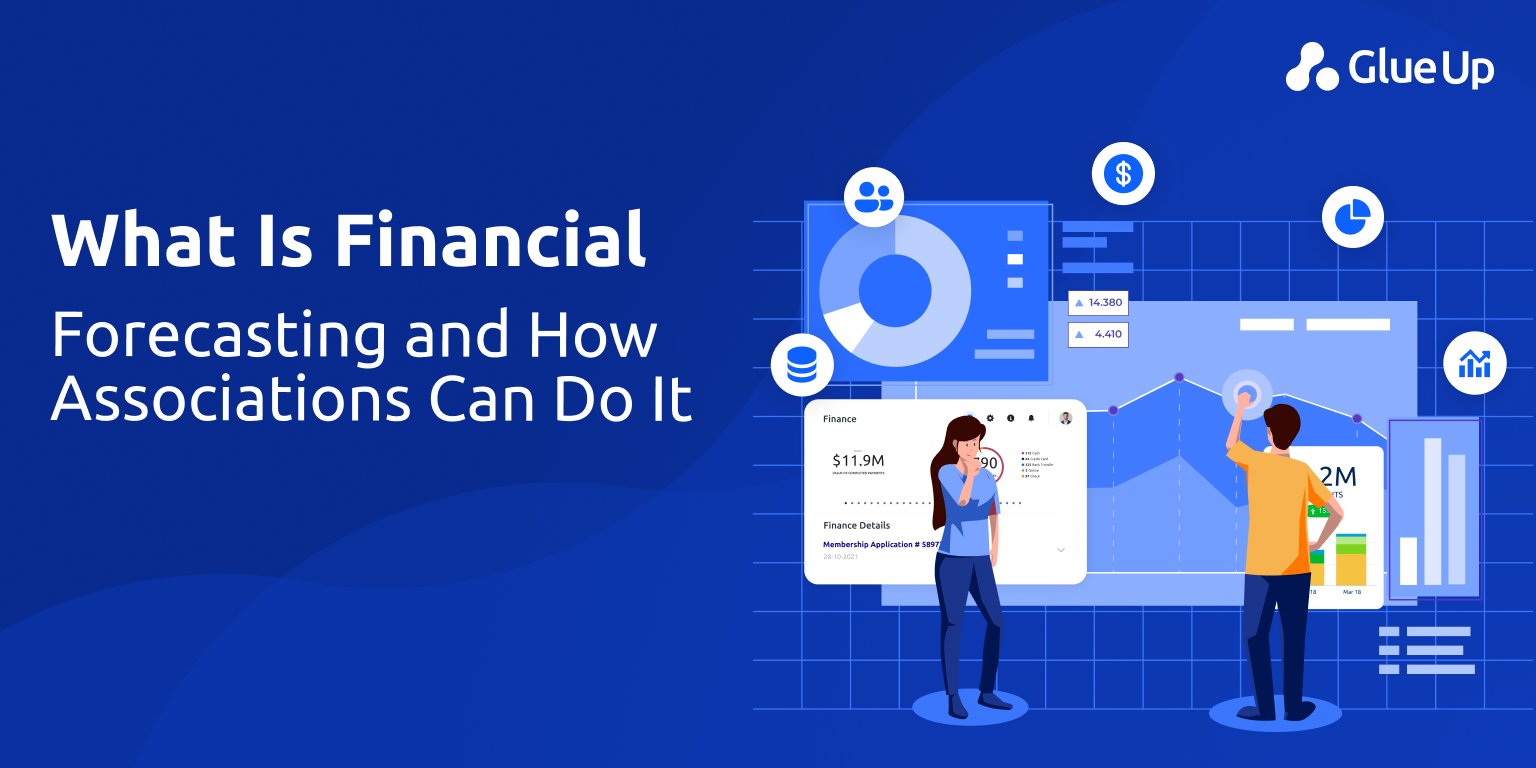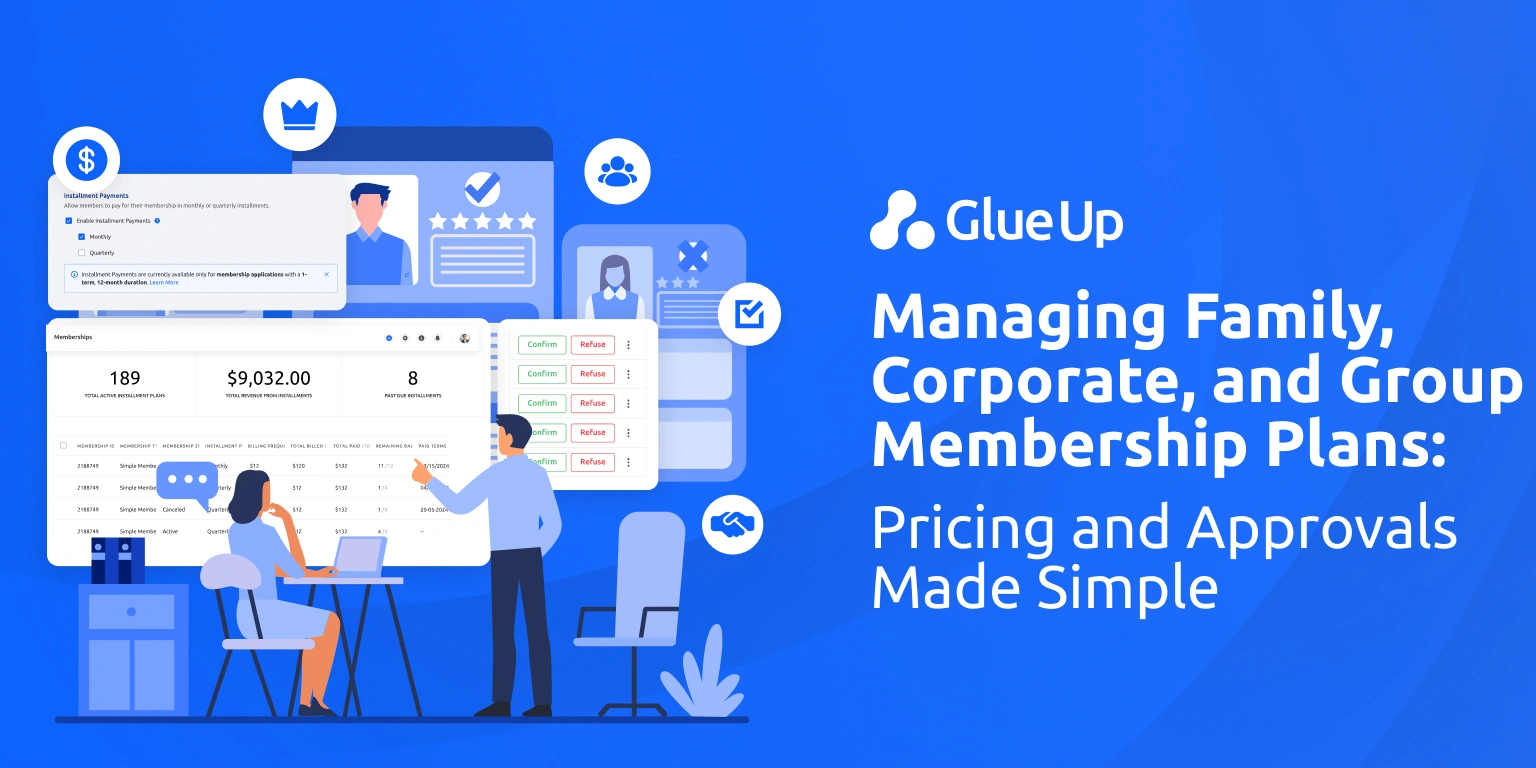
The most common outreach problem in member based organizations is not intent or even message quality. It is persistence. Your team sends one thoughtful email after an event, maybe a follow up a few days later, then moves on. Meanwhile, your best future member is still busy, still interested, and still waiting to hear from you at the exact moment when the timing clicks. That is why this guide centers on sales cadence templates built for associations, chambers, and nonprofits. We will put research to work, map every step to Glue Up, and show you how to run an eight-touch sequence that respects people, earns meetings, and keeps the board happy.
You will get practical language you can paste, channel by channel guidance, and timing that fits a real calendar. You will also see the operating model under the surface: how to prepare lists, how to schedule tasks, how to capture outcomes, and how to measure what matters so you can coach the team without reading every email. Think of this as your field manual for sales cadence templates that actually ship.
Key Takeaways
Eight touches over three weeks is the sweet spot. Most teams quit too early. Plan an 8-touch, 17–21-day cadence so you have enough chances to connect without flooding inboxes.
Lead every call with a clear reason. Open with one sentence that names the specific outcome the prospect wants, then stop talking long enough for a yes. This single line drives most meetings.
Use multi-channel sequences with one useful asset. Mix email, phone, LinkedIn, and a quick voicemail or SMS. On touch 4, include a micro-asset (one-pager or short clip) to tip interest into action.
Personalize in seconds. Mirror the prospect’s job to be done in the subject, reference one event detail or badge category, and keep copy tight. Store outcome lines and assets so reps can tailor fast.
Make it an operating system in Glue Up. Build smart lists, load the sequences, schedule mid-morning call tasks, and track reply and meeting rates by touch number. Pause sequences on replies and coach the opener weekly.
Quick Reads
The Science Behind an Eight Touch Plan and Why Sales Cadence Templates Matter
There is a reason eight touches shows up in prospecting research. In most business-to-business settings, a first meeting usually takes more than one try, and often more than five. The pattern is simple. Early touches find the right person and get on the radar. Mid touches demonstrate value and make it easy to say yes. Late touches offer a graceful out with a clear next step. When you compress all of that into one note, you are not failing. You are under touching.
An eight-touch plan across about three weeks gives you enough chances to connect without overwhelming someone’s inbox. It also lets you vary channels. Email carries detail. A brief call earns attention and lets you sound like a person worth meeting.
A short LinkedIn note adds familiarity without pressure. A polite voicemail or SMS nudge confirms you are real. The research on call mechanics adds one more useful rule for your sales cadence templates. When you call, lead with a clean reason for the call. State the single outcome you think they care about, in normal language, and stop talking long enough to let them say yes.
The last piece is message quality. You do not need clever wordplay. You need relevance, brevity, and a meaningful next step. That is why each template below includes one short line that mirrors what the person told you at the event or in your last email.
It is also why the plan puts a tiny asset in the fourth touch. A useful one pager or short clip can tip someone from interest to action. Put all of that into simple sales cadence templates, and you now have a play the entire team can run.
The Eight-Touch Cadence You Can Paste into Glue Up
Below are four complete sales cadence templates you can run as is. Each includes day spacing, channel, a short script, and why it works. The language is plain on purpose. Edit details to match your programs, keep the spine the same, and your conversion rate will rise.
Template A New Member Prospect from an Event
Day 0: Email
Subject: Your comment about peer connections at [Event Name]
Body, three lines:
Thanks for joining [session]. You mentioned you want peer introductions this quarter.
Members in [group name] typically get two warm intros in month one.
Does a quick call this week help us place you in the right group
Day 2: Call
Open with this line: “Hi [Name], I am with [Organization]. The reason for my call is you said you need two credible peer introductions this quarter. I can set those up through our [group name]. Would a short call tomorrow or Thursday help you decide”
Why it works: Reason first. Outcome next. Short, calm, and clear. This is the single most important sentence in the entire sequence.
Day 4: LinkedIn
Connection note, fifteen words: “Enjoyed your question at [panel]. I can connect you with our [group]. No pitch.”
Day 6: Email with a micro asset
Subject: How members get two quality intros in the first month
Body, three lines and a link:
Here is a one pager on how the process works and who you will meet.
Two open slots next week for first time members.
Choose a time that works for your [link].
Day 9: Call
Repeat the reason. If you reach voicemail, keep it under twenty seconds. Repeat the subject line and the one sentence outcome. End with “I will send the details by email.”
Day 12: Email reply bump
Reply to your last message with one sentence at the top: “I can introduce you to [Member One] and [Member Two] this month. Would you like me to hold those spots”
Day 15: Community preview
Short email or message with a specific invite: “We hold a member discussion on [topic] next Wednesday at 1. I can hold two seats if that helps you decide.”
Day 19: Final call or email
Close confidently and politely: “If now is not the time, I will circle back next quarter. Should I keep you on the invite list for [group]”
Use this pattern in Glue Up sequences. Build a smart list from event attendees, assign the sequence, and set calls for mid morning windows on business days. Your task list will guide the day, and your dashboard will show when replies surge around touches six through eight.
Template B Lapsed Member Win Back
This sales cadence template respects history and focuses on what they valued.
1. Email
Subject: We saved your place in [benefit they used]
Three lines: recall a program they used, list one change or improvement, and offer a ten-minute check in.
2. Call
Reason sentence: “I want to make sure you still receive [specific program] that you used last year. Would a short call tomorrow help confirm what you still need”
3. SMS or voicemail
One sentence and a link. Friendly and quick.
4. Email
Member specific recap: three data points from last year’s usage, two upcoming sessions that match, and your scheduling link.
5. Call
Offer a seat in a committee, working group, or peer circle they once joined.
6. Email
Mini guide: “Three ways members cut costs this month,” one paragraph each, no jargon.
7. LinkedIn
Comment on a post or share a relevant clip without a sales pitch.
8. Email
Choice close: “I can keep your seat on hold through Friday, or we can reconnect in April. What works better”
Glue Up tip: tag lapsed members by last active date, run this sales cadence template as a discrete program, and measure win rates against one touch reminder emails. The difference will be obvious.
Template C Sponsor Outreach For Your Annual Event
Sponsors say yes when they can picture the moment on stage or in the community, not when they get a catalog. This sales cadence template paints that picture.
1. Email
Subject: A credible role at [Event] without a sales pitch
Two lines: describe a non-sales role and mention the audience they care about.
2. Call
Reason sentence: “The reason for my call is to place your team in front of [audience] in a way that feels useful for them and valuable for you.”
3. LinkedIn
Share a short clip from last year’s session that fits their vertical.
4. Email
Menu snapshot: three simple options with clear outcomes, not features. Include one sponsor quote with a number.
5. Call
Confirm fiscal year timing and decision process. Ask, “When does the budget for this kind of work renew, and who weighs in”
6. Email
Hold language: “I can hold the [package name] slot through Friday at three. Option A puts your story in front of [audience]. Option B trades stage time for a year in community.”
7. Voicemail or SMS
Simple reminder. No pressure. Reference the hold.
8. Email
Test month: “If a full year is hard now, we can run a test month in community with measurable outcomes.”
Use Glue Up to store the sponsor menu as reusable content blocks, then drop them into this sales cadence template. Track meetings set by touch number so you can coach toward the moments that matter.
Template D Event Attendee to Member
Attendees are your warmest list. This sales cadence template turns that warmth into a meeting within seven to twenty days.
1. Email
Subject: Two member sessions that match your badge
Body: list the two sessions by name and date and offer a short placement call.
2. Call
Reason sentence: “I want to place you in the right member group while seats are still open.”
3. LinkedIn
Post events thank you and photo album link. No ask.
4. Email
Forty-eight-hour follow up package with slides, links, and the next two relevant invitations.
5. Call
Invite to a micro roundtable with six seats. Make it real by naming two seats already taken by known members.
6. Email
Short case: one story from a member who joined after the same event. Use three sentences.
7. Email or SMS
Gentle reminder that one seat is still open. Include the date and time.
8. Email
Graceful exit: “Happy to reconnect in Q2. Want to stay on the invite list for [topic]”
Copy Building Blocks You Can Reuse Across Sales Cadence Templates
Great sales cadence templates do not need long scripts. They need a few reliable building blocks you can reuse without sounding canned.
Cold call opener that earns time
“Hi [Name], this is [Your Name] with [Organization]. The reason for my call is [outcome in one short sentence tied to their role or their event comment]. Do you have a few minutes this week to see if it fits”
Value bump email you can send in under two minutes
Subject: Three ways members use [program] this month
Body:
• [Outcome one] in one sentence
• [Outcome two] in one sentence
• [Outcome three] in one sentence
Close: “If that is useful, I can walk you through where to start on a quick call.”
Proof insert that does not feel like bragging
“[Peer organization] used [program] to reach [audience] and booked [number] meetings in thirty days.”
Nudge that respects autonomy
“Should I hold a seat for [date], or circle back next month”
Voicemail that gets returned
“[Name], [Your Name] with [Organization]. I am calling because you asked about [outcome]. I can set [specific next step]. I will send an email with the details. Reply with a time that works.”
Put these blocks in your team’s shared library, label them by persona and program, and link them to the right sales cadence templates in Glue Up. People write faster when the first draft is one click away.
Personalization That Scales Without Burning Hours
Personalization is not a paragraph about the prospect’s alma mater. It is a sentence that reflects what they want next. Use these rules to keep your sales cadence templates fast and specific.
Mirror the job to be done in the subject line. If they said “introductions,” say “Two credible introductions this month.”
Borrow one detail from a session, a badge category, or a line they shared in the chat.
Use a micro asset that solves a tiny problem. A one pager that shows how to get the first five intros is better than a thirty slide deck.
Treat LinkedIn as an assist. Connection and context, not a pitch.
Keep a small library of twenty outcome lines per segment so every rep can personalize in seconds.
Glue Up tip: store interest tags from events and forms, then add tokens for those tags inside your sales cadence templates. The copy feels tailored because it is, and your time investment stays sane.
Governance And Measurement Inside Glue Up
The best writing in the world does not help if the operating system is messy. Here is how to make these sales cadence templates real.
Lists that stay fresh
Build smart lists for four motions: new member from events, lapsed member win back, sponsor outreach, and attendee to member. Define clear entry rules and exit rules. For example, “entered the list if they attended [event] in the last thirty days and are not a member,” and “exit the list if a meeting is booked or if they opt out.”
Sequences mapped to the calendar
Load the eight touch steps into Glue Up sequences with spacing across seventeen to twenty-one days. Schedule call tasks for mid-morning windows. Avoid Fridays for final asks. Make the calendar structure part of the sales cadence templates so no one thinks about timing while doing the work.
Coaching that fits busy schedules
Coach the opener, not the entire call. Review two recorded calls per rep per week. Score whether the reason sentence is clear, whether the outcome is specific, and whether the rep stopped talking early enough to earn a yes.
Dashboards that show reality
Pin tiles for reply rate by touch number, meeting set rate by program, time to first meeting, top subject lines, and no response by persona. You will likely see a spike in meetings around touches five through eight. Share that chart at the team stand up. It changes behavior fast because it shows why persistence matters.
Handoff that feels clean
When a meeting books, auto create the next task for the rep who will run discovery, attach the event notes or sponsor context, and include the two outcome lines the prospect has already acknowledged. Good sales cadence templates lead to good handoffs.
Practical Questions People Ask About Sales Cadence Templates
How many touches does it really take?
Plan for eight. Some meetings book sooner, and some will take more, but eight is the realistic average for busy professionals.
How long should the cadence run?
Seventeen to twenty-one days works well for most motions. You want enough time between touches to feel human, and enough momentum to stay top of mind.
When should I call?
Mid-morning and mid-week help a little, but message quality matters more. If you only have one window a day, take it. A good reason sentence beats perfect timing.
How do I avoid sounding pushy?
Offer a clear outcome and a small next step. Use a graceful close on the final touch and give people an easy way to say not now without closing the door.
What if someone replies in the middle of the cadence?
Pause the sequence automatically when a meeting books or when a conversation starts. Glue Up lets you automate that pause so no one gets an extra message by accident.
Where do we put all the assets?
Store one pagers, short clips, and quotes in the content library and link them by segment. Your sales cadence templates should reference assets by name, so reps grab the right one fast.
How To Launch in One Week
You can get these sales cadence templates live in five working days with a simple plan.
Day 1: Choose two motions to start. For most teams, that is event attendee to member and lapsed member win back. Draft the reason lines and the one pager for Touch Four.
Day 2: Build smart lists and create sequences in Glue Up. Copy the eight steps, add your tokens, and set calls for mid-morning.
Day 3: Run a one-hour clinic on the opener. Practice the reason sentence out loud. Aim for tone that sounds like a peer, not a pitch.
Day 4: Ship. Send Touch One to a small cohort. Spot check five messages. Confirm that replies pause sequences.
Day 5: Review the first calls, fix any broken tokens, and agree on the coaching micro goals for next week. Keep it to one skill at a time.
In week two and week three, introduce the sponsor cadence, then the event to member cadence. By week four, the entire team will be using the same sales cadence templates with minor edits for segments, and your dashboards will start to show patterns you can trust.
Close Stop Guessing and Start Shipping
Eight touches are not aggressive. It is average. Your members and sponsors are not avoiding you. They are busy. A clean sequence that leads with value, uses a short reason line on calls, and offers a next step people can accept will earn meetings.
Put these sales cadence templates into Glue Up, set the tasks, and coach the opener. You will notice the difference in booked meetings within a month, and you will build a discipline that new team members can learn in a week.



